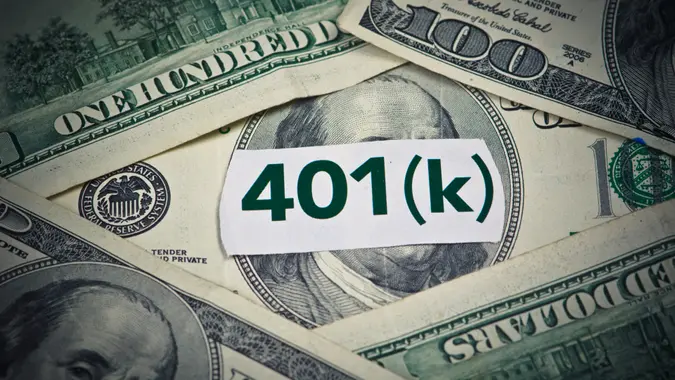How Does a Roth IRA Grow?

Commitment to Our Readers
GOBankingRates' editorial team is committed to bringing you unbiased reviews and information. We use data-driven methodologies to evaluate financial products and services - our reviews and ratings are not influenced by advertisers. You can read more about our editorial guidelines and our products and services review methodology.

20 Years
Helping You Live Richer

Reviewed
by Experts

Trusted by
Millions of Readers
A Roth IRA grows in three main ways: through your contributions, returns on investments like stocks and mutual funds, and the power of compound interest. Together, these forces create tax-free growth that can accelerate over time — giving Roth IRAs a unique edge over 401(k)s and traditional IRAs, where withdrawals are taxed in retirement.
In this article, we’ll break down how each growth driver works, how Roth compounding differs from pre-tax accounts, ways to boost growth by reinvesting gains and dividends, and how withdrawals can slow your momentum.
How Contributions Help a Roth IRA Grow
Your contributions form the foundation of your Roth IRA’s growth. Each year, the IRS limits how much you can contribute — in 2025, that’s up to $7,000, or $8,000 if you’re age 50 or older.
What makes Roth IRAs unique is how they’re funded. Traditional IRAs and 401(k)s use pre-tax dollars, which gives you an upfront deduction but leads to taxes later when you withdraw the money. Roth IRAs flip that model — you contribute after-tax income, which allows your savings to grow tax-free and lets you make tax-free withdrawals in retirement. That means the full power of compounding stays in your account for decades.
As a bonus, Roth IRAs offer unmatched flexibility: you can withdraw your contributions — though not your investment earnings — at any time, for any reason, without penalties or taxes.
How Investments Grow Inside a Roth IRA
Money you invest in a Roth IRA doesn’t just sit there collecting a modest yield, like in a savings account. Roth IRAs are brokerage accounts with special tax privileges that serve as a vehicle for trading investments, including, but not limited to:
- Stocks
- Bonds
- ETFs
- Index funds
- Mutual funds
- CDs
- Cryptocurrency
As with all investments, growth depends on market performance, asset allocation, diversification and your strategy, discipline and consistency. The basic rules remain unchanged. For example, higher-risk bets, such as stocks, bring more risk but less reward potential than safer bets, like bonds. The type of account your securities are parked in has no bearing on their performance one way or the other, and no account safeguards against events like economic downturns and market crashes.
The Power of Compound Interest in a Roth IRA
No matter what you invest in, compound interest is what turns steady savings into real wealth — as long as you give it time to work.
Compounding means your earnings generate even more earnings. Each year’s gains are added to your principal, and future growth is calculated on that larger total. It may start slowly, but over decades, compounding becomes one of the most powerful forces in finance — which is why starting early, even with small contributions, makes such a difference.
See how starting early pays off:
| Investment horizon | Scenario | Total contributions | Value at age 65 (10% annual return) |
|---|---|---|---|
| 40 years (age 25-65) | Contribute $1,000 per year | $40,000 | $442,590 — all tax-free in a Roth IRA |
| 20 years (age 45-65) | To reach the same $442,590, you’d need to invest $65,782 upfront or save $7,728 per year | $154,560 | $442,590 |
This simple example shows why time is your greatest asset. The earlier you start, the more compounding can magnify your returns — and in a Roth IRA, those gains can grow entirely tax-free.
How Dividends and Capital Gains Grow in a Roth IRA
Dividends and capital gains can quietly supercharge your Roth IRA’s growth — especially when you reinvest them instead of taking them as income. Many Roth IRA providers offer a dividend reinvestment plan (DRIP), which automatically channels dividends from your stocks, ETFs, or REITs back into new shares. Over time, those reinvested dividends compound on themselves, adding a powerful layer of growth.
Let’s look at how that plays out over time:
| Investor strategy | Reinvests dividends | Cashes out dividends |
|---|---|---|
| Annual contribution | $1,000 | $1,000 |
| Annual return | 10% + 3% dividend yield (reinvested) | 10% + 3% dividend yield (withdrawn) |
| 30-year balance | $289,200 | $164,496, plus $36,000 in withdrawn dividends (total $200,496) |
By reinvesting instead of cashing out, the investor ends up with nearly 45% more wealth — all growing tax-free inside the Roth IRA. And here’s the kicker: unlike taxable brokerage accounts, the IRS doesn’t tax your dividends or capital gains in a Roth IRA, whether you reinvest them or not.
How Roth IRA Growth Compares to a Traditional IRA
The biggest difference between a Roth IRA and a traditional IRA comes down to when you pay taxes — before or after your money grows.
- Roth IRA: Contributions are made with after-tax dollars, meaning you’ve already paid taxes on the money you invest. The tradeoff is worth it — your investments grow tax-free, and qualified withdrawals in retirement are also tax-free.
- Traditional IRA: Contributions are made with pre-tax money, which lowers your taxable income now. However, you’ll pay ordinary income taxes on withdrawals in retirement.
Both accounts can help you build long-term wealth, but the right choice depends on your future tax outlook. If you expect to be in a higher tax bracket later, a Roth IRA often makes more sense for maximizing after-tax growth.
How Withdrawals Can Slow Your Roth IRA’s Growth
Just as cashing out dividends can weaken compounding, so can making withdrawals. Compound growth depends on having a larger balance to build on — when you withdraw funds, you shrink the amount that can earn future returns, interrupting the snowball effect.
While Roth IRAs are known for flexibility — allowing you to withdraw your contributions (not earnings) at any time without penalties or taxes — dipping into your account early can cost you far more in lost growth than you might realize.
Even small withdrawals reduce the base that drives compounding over decades. The smartest move? Keep your money invested, contribute regularly, and let compounding do its work uninterrupted. The longer your funds stay untouched, the harder your Roth IRA can work for you.
The Bottom Line: Let Time and Consistency Do the Work
Roth IRAs offer rare advantages — tax-free growth, flexible withdrawals, and the potential to build long-term wealth without future tax bills. But even with these perks, the core principles of investing stay the same: contribute consistently, invest wisely, and give compounding time to work its magic.
Start early, stay steady, and let your Roth IRA grow quietly in the background — the payoff decades from now will be worth it.
FAQ
- What investments make a Roth IRA grow the fastest?
- Growth potential in a Roth IRA depends on the level of risk you’re willing to take. Historically, stocks — particularly broad market index funds and ETFs — have offered the highest long-term returns, though they also carry more volatility. Balancing stocks with bonds or other stable assets helps manage risk while still allowing for meaningful growth.
- How much can a Roth IRA grow in 20 or 30 years?
- That depends on your contributions, returns, and how consistently you invest. For example, contributing just $1,000 a year and earning an average 10% return could grow to more than $170,000 in 30 years — all tax-free. With steady contributions and dividend reinvestment, your balance can realistically reach well into the six figures over time.
- Do dividends and capital gains in a Roth IRA get taxed?
- No — that’s one of the biggest advantages of a Roth IRA. Dividends and capital gains grow tax-free as long as they remain in the account, and qualified withdrawals after age 59½ are also completely tax-free.
- Can you lose money in a Roth IRA if the market drops?
- Yes. A Roth IRA doesn’t protect you from market risk — it simply shields your gains from future taxes. If your investments lose value, your account balance can drop, just as it would in a regular brokerage account. Diversification and a long-term mindset are key to weathering market fluctuations.
- Does reinvesting dividends increase growth in a Roth IRA?
- Yes. Dividend reinvestment plans (DRIPs) allow your earnings to buy more shares automatically, which compounds your returns over time. In a Roth IRA, those reinvested dividends grow tax-free, accelerating your long-term gains even further.
 Written by
Written by  Edited by
Edited by 

























